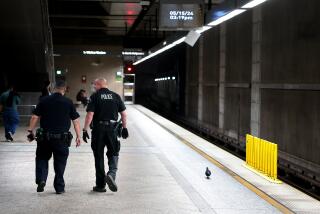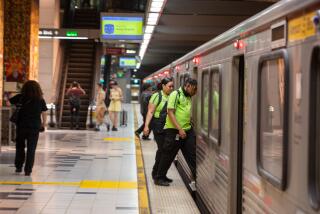Car Restorer : He Chases the Past With a Passion in a Nash Metropolitan
- Share via
People who think joint ventures between U.S. and foreign automobile companies are a new phenomenon probably don’t know about a snub-nosed creature of the 1950s called the Nash Metropolitan.
Long before General Motors and Toyota got together, before Mitsubishi built engines for Chrysler, the American Motors Corp. turned to the British car companies of Fisher & Ludlow Ltd. and Austin Motor Co. Ltd. in 1954 and had them produce what Jim Valentine of North Hollywood says was the first “really successful,” mass-produced compact car. Valentine ought to know. The Nash Metropolitan--12 feet long, 5 feet wide and 4 feet high--is a big part of his life. He speaks of the 1950s as “the Metropolitan era.”
It is a time in history that can be re-entered by passing through the door of the Metropolitan Pit Stop on Laurel Canyon Boulevard, where Valentine restores Metropolitans and sells them.
Has Character
He also sells parts for the cars and runs a club for about 100 Metropolitan owners in the area. He is planning to renovate the business, which he admits looks “dowdy,” and build a small museum that will pay homage to the object of his nostalgic passion.
The Metropolitan is to cars what the beagle is to dogs. Let others have power. Let others have beauty. The Metropolitan has character. Besides, in its day, it cost about $1,500 and got 28 to 40 miles to the gallon, depending on the car’s condition. It came in a variety of oddly bright colors that one automotive writer of the time said were like those of “Neapolitan ice cream.”
“Some people say it’s an ugly car, but then some people say the Mercedes is an ugly car,” said the 59-year-old Valentine, who runs the business with his wife, Eve. “I’ve had cartoonists buy them, and when I ask them why they bought them, they say, ‘It’s artistic.’ ”
Autographed Albums
The Metropolitan Pit Stop coexists with the Valentine Recording Studios, the business that he says was his previous principal hobby. Valentine is one of those people who uses the word “hobby” where others might talk about a preoccupation.
A gold razor blade that he wears on a chain around his neck symbolizes his skill at editing recording tape, he said. For years, he honed that skill by hosting recording sessions for the likes of Bing Crosby and Stan Kenton.
Crosby, Kenton and numerous others unfailingly autographed the record albums and photographs that line the walls of the studio, which itself is a kind of museum with a subtle art deco feel in which someone who habitually used the word “cool” would not be out of place.
The focus of Valentine’s attention these days is out back, where dozens of Metropolitans in various stages of decay crowd a lot outside a little garage, their windshields shattered, their undersized bodies rusted and dented, desperate for restoration. Working in the garage on the ones chosen for a new life is John Huston, a salaried mechanic whom Valentine hired in 1982 when he decided there would be a market for the rebuilt cars.
“It all started when we had a little 1957 Thunderbird stolen from our house in 1973,” Valentine explained. “It was around the time of the first oil crunch and we looked around for a car to get, so I remembered the Nash Metropolitan.”
He advertised for a Metropolitan in various newspapers and ended up buying one from a woman in Oxnard. Soon, though, it became clear that the car was ailing. Part after part began to go and mechanic after mechanic told Valentine, “I’m sorry, but your car is obsolete.”
Nash-Kelvinator Design
The Metropolitan was designed by the former Nash-Kelvinator Corp. in 1949 and 1950. In 1954, Nash-Kelvinator became part of the American Motors Corp. Austin Motor built 94,986 of the cars according to American Motors specifications, and the cars were sold from 1954 to 1962. Two models were offered, a two-door convertible and a two-door hardtop.
Valentine’s diligence led him to American Motors dealers who still had old Metropolitan parts, and he began to stockpile them. He also wrote to the original manufacturers and subcontractors. Other Metropolitan owners who had heard about his growing collection began asking if they could buy parts.
In 1976 Valentine learned about a company that had made plastic taillight frames to replace the originals, which seemed to deteriorate on the old Metropolitans with particular regularity. The company found the old molds. Valentine wanted the frames, or “bezels,” to be redone with a better kind of plastic. It would cost $18,000 for 5,000 bezels.
“We were at the brink, at the point where you decide you’re going to start a company or not,” he said. He went ahead.
$2,500 to $8,900 Range
Until 1982, his business was selling the parts. He developed an inventory of about 800 new Metropolitan parts, many of them made by the original manufacturers, which he stores in a warehouse in North Hollywood. In 1983 he hired Huston and began resurrecting the old cars. The prices for a rebuilt Metropolitan range between $2,500 and $8,900, depending on the degree to which he restores it. He has sold about six of them and has restored about six others for customers who took cars to him.
Valentine says the business has been, at best, only slightly profitable, but he has high expectations that involve redesigning the front of his building and the planned museum. Now there is a rear portion of a Metropolitan embedded in the concrete above the door of the Pit Stop. He plans to sink the whole side of a car into the area above the door.
Then there is the museum. Into it will go a one-of-a-kind, silvery, futuristic Metropolitan designed in 1956. With its spiked tail fins and electronically controlled plastic bubble-top, it looks the way a space shuttle might have if it had been designed by Flash Gordon. Valentine says it was used in several motion pictures.
Valentine believes that, when the museum and remodeled store are finished, business will take off.






